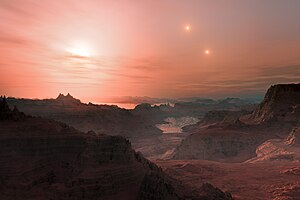葛利斯667
此條目可能包含原創研究。 (2019年11月10日) |
| 觀測資料 曆元 J2000 | |
|---|---|
| 星座 | 天蠍座 |
| 星官 | |
| 赤經 | 17h 18m 57.16483s[1] |
| 赤緯 | −34° 59′ 23.1416″[1] |
| 視星等(V) | 5.91/7.20/10.20[2] |
| 特性 | |
| 光譜分類 | K3V/K5V/M2[2] |
| U−B 色指數 | 0.83/???/1.17 |
| B−V 色指數 | 1.03/???/1.57 |
| 變星類型 | A:疑似變星 B:未知 C:耀星 |
| 天體測定 | |
| 徑向速度 (Rv) | 0 km/s |
| 自行 (μ) | 赤經:1129.76[1] mas/yr 赤緯:−77.02[1] mas/yr |
| 視差 (π) | 146.29 ± 9.03[1] mas |
| 距離 | 22 ± 1 ly (6.8 ± 0.4 pc) |
| 絕對星等 (MV) | 7.07/8.02/11.03 |
| 詳細資料 | |
| 格利澤667AB | |
| 質量 | 0.73 / 0.69[3] M☉ |
| 半徑 | 0.76 / 0.70[2] R☉ |
| 金屬量 [Fe/H] | –0.59[4] dex |
| 格利澤667C | |
| 質量 | 0.31[5] M☉ |
| 半徑 | 0.42[2] R☉ |
| 亮度 | 0.0137[5] L☉ |
| 溫度 | 3,700 ± 100[5] K |
| 自轉 | 105 days [5] |
| 年齡 | 2-10[5] Gyr |
| 軌道 | |
| 伴星 | 格利澤667B[6] |
| 繞行週期 (P) | 42.15 yr |
| 半長軸 (a) | 1.81" |
| 偏心率 (e) | 0.58 |
| 傾斜角 (i) | 128° |
| 升交點黃經 (Ω) | 313° |
| 近心點 曆元 (T) | 1975.9 |
| 近心點幅角 (ω) (secondary) | 247° |
| 其他命名 | |
| 參考資料庫 | |
| SIMBAD | 資料 |
| 參考資料庫 | |
| SIMBAD | 資料 |
| 系外行星資料庫 | 資料 |
| ARICNS | 資料 |
| 系外行星百科 | 資料 |
格利澤667(英語:Gliese 667,又稱HR 6426或MLO 4)是天蠍座的一個三恆星系統,離地球大約6.97秒差距(22.7光年)。除了三個相互有引力約束的恆星系統外,它還包括第四個光學密近成員(視星等為12),這個第四成員與上述三恆星系統沒有引力約束,但用裸眼看來這四顆星就仿佛是一顆暗星,視星等為5.89。該系統有着相對較高的運行速度,每年超過1角秒。
恆星系統
[編輯]系統中最亮的兩個成員格利澤667A和格利澤667B之間形成一個偏心軌道,軌道離心率0.58,平均距離12.6天文單位或1.8角秒,最近至5天文單位,最遠至20天文單位[note 1][7]。軌道週期大約是42.15年,並且軌道平面和從地球觀測的視線夾角128°。環繞兩顆較亮成員星的格利澤667C的軌道較遠,至少距離230天文單位,或相當於30角秒[5][8]。
格利澤667A
[編輯]三星系統中最大的格利澤667A是一顆光譜型為K3V的橙矮星[2]質量為太陽的73%[3],半徑則是太陽的76%[2],但光度只有太陽的12-13%[9]。該恆星的金屬量是遠低於太陽的26%[4],視星等6.29,絕對星等7.07(假設忽略了星際物質的消光)。
格利澤667B
[編輯]格利澤667B是一顆光譜型為K5V的橙矮星,質量為太陽的69%[3],或者是主星的95%。它的可見光度為太陽的5%,視星等7.24,絕對星等8.02。
格利澤667C
[編輯]格利澤667C是三星系統中體積最小的成員星,質量為太陽的31%[3],半徑則是太陽的42%[2],是一顆光譜型為M2V的紅矮星。它的光度只有太陽的1.4%,表面有效溫度 3,700 K[5]。如此的表面溫度讓它的表面呈紅色 M 型恆星[10]。它的視星等10.25,絕對星等11.03。目前已知它擁有至少5顆,可能最多7顆行星。
自格利澤667C的表面起算,它的行星系第二顆行星格利澤667Cc軌道位於適居帶中央。在該行星格利澤667Cc上,格利澤667C的角直徑是1.24°,是從地球所見太陽角直徑的2.3倍[note 2]。格利澤667C在格利澤667Cc的天球上占據的面積將是在地球的天球上太陽面積的5.4倍,但是它的面積仍只占格利澤667Cc天球的0.003%,或者是在格利澤667Cc天頂時占據0.006%。
行星系統
[編輯]

天文學家量測格利澤667的徑向速度時,於2009到2013年間先後確認了格利澤667C旁有5顆系外行星:格利澤667Cb、格利澤667Cc、格利澤667Ce、格利澤667Cf和格利澤667Cd,另外還有2顆尚未確認行星的訊號(格利澤667Cg可能性較高,而格利澤667Ch仍存疑)[5][11]。初始分析指出,該系統的行星質量不能在其質量下限兩倍以上,否則系統會不穩定。從地球方向觀測該系統時,它的軌道傾角會略有限制[11]。
格利澤667Cb是由 HARPS 團隊宣布和其他29顆行星發現於2009年10月19日,而格利澤667Cc則是由相同團隊由2011年11月21日的論文預印本公開[12]。然而,後者正式宣布發現則是於2012年2月2日由卡內基研究所和哥廷根大學科學家組成的團隊所著的論文中公開[5][13]。在該正式論文中,格利澤667Cc被認為是液態水最可能存在的系外行星之一,並且是潛在適合生命存在的行星[14]。格利澤667Cc更進一步的軌道分析和更精確的軌道參數結果都已經發表[5]。基於母恆星的熱光度,格利澤667Cc表面接收的輻射通量將相當於地球表面的90%[9],不過照射到格利澤667Cc表面的電磁波段大多落在屬於不可見光的紅外線。基於黑體的溫度計算,格利澤667Cc接收的電磁輻射波段將比地球表面更廣泛,因此表面平均溫度將稍高於地球(277.4 K,地球表面平均溫度254.3 K),並且它的位置比地球更接近母恆星的適居帶熱邊界[來源請求]。
| 成員 (依恆星距離) |
質量 | 半長軸 (AU) |
軌道周期 (天) |
離心率 | 傾角 | 半徑 |
|---|---|---|---|---|---|---|
| b | 5.94 - 12 M⊕ | 0.050 432 ± 0.000 001 | 7.2006 | 0.112 | >30° | — |
| h[查證請求] (未確認) | ≥1.3 - 2.6[原創研究?] M⊕ | 0.085[原創研究?] | ~17[原創研究?] | [原創研究?] | ||
| c | ≥3.86 - 7.8 M⊕ | 0.125 07 ± 0.000 06 | 28.1231 | 0.001 | >30° | — |
| f | ≥1.94 - 4[原創研究?] M⊕ | 0.155 75 ± 0.000 17[原創研究?] | 39.0819[原創研究?] | 0.001[原創研究?] | >30[原創研究?]° | — |
| e | ≥2.68 - 5.4[原創研究?] M⊕ | 0.212 57 ± 0.000 35[原創研究?] | 62.2657[原創研究?] | 0.001[原創研究?] | >30[原創研究?]° | — |
| d (未確認) | ≥5.21 - 10.4[原創研究?] M⊕ | 0.275 8 ± 0.000 3[原創研究?] | 92.0926[原創研究?] | 0.019[原創研究?] | ||
| g | ≥4.41 - 8.8[原創研究?] M⊕ | 0.538 9 ± 0.000 5[原創研究?] | 251.519[原創研究?] | 0.107[原創研究?] | >30[原創研究?]° | — |
註釋
[編輯]參考資料
[編輯]- ^ 1.0 1.1 1.2 1.3 1.4 van Leeuwen, F., Validation of the new Hipparcos reduction, Astronomy and Astrophysics, November 2007, 474 (2): 653–664, Bibcode:2007A&A...474..653V, arXiv:0708.1752
 , doi:10.1051/0004-6361:20078357
, doi:10.1051/0004-6361:20078357
- ^ 2.0 2.1 2.2 2.3 2.4 2.5 2.6 Pasinetti Fracassini, L. E.; et al, Catalogue of Apparent Diameters and Absolute Radii of Stars (CADARS) - Third edition - Comments and statistics, Astronomy and Astrophysics, February 2001, 367: 521–524, Bibcode:2001A&A...367..521P, arXiv:astro-ph/0012289
 , doi:10.1051/0004-6361:20000451 Note: see VizieR catalogue J/A+A/367/521 (頁面存檔備份,存於網際網路檔案館).
, doi:10.1051/0004-6361:20000451 Note: see VizieR catalogue J/A+A/367/521 (頁面存檔備份,存於網際網路檔案館).
- ^ 3.0 3.1 3.2 3.3 Tokovinin, A., Comparative statistics and origin of triple and quadruple stars, Monthly Notices of the Royal Astronomical Society, September 2008, 389 (2): 925–938, Bibcode:2008MNRAS.389..925T, arXiv:0806.3263
 , doi:10.1111/j.1365-2966.2008.13613.x
, doi:10.1111/j.1365-2966.2008.13613.x
- ^ 4.0 4.1 Cayrel de Strobel, G.; Soubiran, C.; Ralite, N., Catalogue of [Fe/H] determinations for FGK stars: 2001 edition, Astronomy and Astrophysics, July 2001, 373: 159–163, Bibcode:2001A&A...373..159C, arXiv:astro-ph/0106438
 , doi:10.1051/0004-6361:20010525
, doi:10.1051/0004-6361:20010525
- ^ 5.00 5.01 5.02 5.03 5.04 5.05 5.06 5.07 5.08 5.09 Anglada-Escude, Guillem; et al, A planetary system around the nearby M dwarf GJ 667C with at least one super-Earth in its habitable zone (PDF), The Astrophysical Journal Letters, February 2012,, accepted [2013-06-27], Bibcode:2012arXiv1202.0446A, arXiv:1202.0446
 , (原始內容存檔 (PDF)於2021-01-25)
, (原始內容存檔 (PDF)於2021-01-25)
- ^ Söderhjelm, Staffan, Visual binary orbits and masses POST HIPPARCOS, Astronomy and Astrophysics, January 1999, 341: 121–140, Bibcode:1999A&A...341..121S
- ^ Bowman, Richard L. Interactive Planetary Orbits - Kepler's Laws Calculations. [23 February 2012]. (原始內容存檔於2012年12月12日).
- ^ Philip C. Gregory. Additional Keplerian Signals in the HARPS data for Gliese 667C from a Bayesian Re-analysis. arXiv:1212.4058
 .
.
- ^ 9.0 9.1 Sven Wedemeyer-Böhm. Life on Gliese 667Cc?. Institute of Theoretical Astrophysics. [2013-06-27]. (原始內容存檔於2013-07-03).
- ^ The Colour of Stars, Australia Telescope, Outreach and Education (Commonwealth Scientific and Industrial Research Organisation), December 21, 2004 [2012-01-16], (原始內容存檔於2012-03-10)
- ^ 11.0 11.1 Anglada-Escudé, Guillem; Tuomi, Mikko; Gerlach, Enrico; Barnes, Rory; Heller, René; Jenkins, James S.; Wende, Sebastian; Vogt, Steven S.; Butler, R. Paul; Reiners, Ansgar; Jones, Hugh R. A. A dynamically-packed planetary system around GJ 667C with three super-Earths in its habitable zone (PDF). Astronomy & Astrophysics. 2013-06-07 [2013-06-25]. doi:10.1051/0004-6361/201321331. (原始內容存檔 (PDF)於2013-06-30).
- ^ Bonfils, X.; et al, The HARPS search for southern extra-solar planets XXXI. The M-dwarf sample, Astronomy and Astrophysics, November 2011,, submitted, Bibcode:2011arXiv1111.5019B, arXiv:1111.5019

- ^ University of Göttingen. Presseinformation: Wissenschaftler entdecken möglicherweise bewohnbare Super-Erde - Göttinger Astrophysiker untersucht Planeten in 22 Lichtjahren Entfernung. Nr. 17/2012 - 02.02.2012. Announcement on university homepage, retrieved 2012-02-02 (頁面存檔備份,存於網際網路檔案館)
- ^ Chow, Denise. Newfound Alien Planet is Best Candidate Yet to Support Life, Scientists Say. Space.com. February 2, 2012 [February 3, 2012]. (原始內容存檔於2021-02-14).
外部連結
[編輯]- MLO 4. SolStation. [July 9, 2006]. (原始內容存檔於2019-04-23).
- Leave your message to the Gliese667ccians here .... SolStation. [April 27, 2012]. (原始內容存檔於2012年5月31日).










